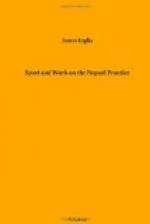The marks of their claws are often seen on trees in the vicinity of their haunts, and from this fact many ridiculous stories have got abroad regarding their habits. It has even been regarded by some writers as a sort of rude test, by which to arrive at an approximate estimate of the tiger’s size. A tiger can stretch himself out some two or two and a half feet more than his measurable length. You have doubtless often seen a domestic cat whetting its claws on the mat, or scratching some rough substance, such as the bark of a tree; this is often done to clean the claws, and to get rid of chipped and ragged pieces, and it is sometimes mere playfulness. It is the same with the tiger, the scratching on the trees is frequently done in the mere wantonness of sport, but it is often resorted to to clear the claws from pieces of flesh, that may have adhered to them during a meal on some poor slaughtered bullock. These marks on the trees are a valuable sign for the hunter, as by their appearance, whether fresh or old, he can often tell the whereabouts of his quarry, and a good tracker will even be able to make a rough guess at its probable size and disposition.
Like policemen, tigers stick to certain beats; even when disturbed, and forced to abandon a favourite spot, they frequently return to it; and although the jungle may be wholly destroyed, old tigers retain a partiality for the scenes of their youthful depredations; they are often shot in the most unlikely places, where there is little or no cover, and one would certainly never expect to find them; they migrate with the herds, and retire to the hills during the annual floods, always coming back to the same jungle when the rains are over.
Experienced shekarries know this trait of the tiger’s character well, and can tell you minutely the colour and general appearance of the animals in any particular jungle; they are aware of any peculiarity, such as lameness, scars, &c., and their observations must be very keen indeed, and amazingly accurate, as I have never known them wrong when they committed themselves to a positive statement.
An old planter residing at Sultanpore, close on the Nepaul border, a noted sportsman and a crack shot, was charged on one occasion by a large tiger; the brute sprang right off the ground on to the elephant’s head; his hind legs were completely off the ground, resting on the elephant’s chest and neck; Mr. F. retained sufficient presence of mind to sit close down in his howdah; the tiger’s forearm was extended completely over the front bar, and so close that it touched his hat. In this position he called out to his son who was on another elephant close by, to fire at the tiger; he was cool enough to warn him to take a careful aim, and not hit the elephant. His son acted gallantly up to his instructions, and shot the tiger through the heart, when it dropped down quite dead, to Mr. F.’s great relief.
Some sportsmen are of opinion, that the tiger when charging never springs clear from the ground, but only rears itself on its hind legs; this however is a mistake. I saw a tiger leap right off the ground, and spring on to the rump of an elephant carrying young Sam S. The elephant proved staunch, and remained quite quiet, and Sam, turning round in his howdah, shot his assailant through the head.




